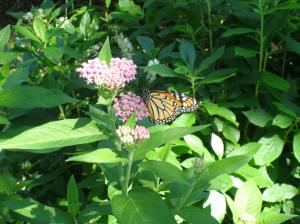Little did we members of the Native Herb Conservation Committee know when we chose redring or white milkweed (Asclepias variegata) the Notable Native Herb for 2014 that monarch butterflies would suffer a precipitous drop in numbers in the summer of 2013.
We were well aware of the uses of many members of the Asclepias genus for medicines, food and fiber and we knew we wanted to highlight its importance as a larval food source for Danaus plexippus. Even then, it was clear that monarch butterfly numbers were continuing to drop due to habitat loss and pesticide use and it was our intention to help in the effort to bring that to our members’ attention. But we could not have anticipated that there would be the fewest adults measured in recent memory during the summer and fall of 2013 and that the cry to preserve and restore habitat by planting regionally appropriate milkweed species would be such a focus for the spring of 2014.
Although a large number of Asclepias species may be found throughout the continental US and into Canada and Mexico, Asclepias variegata has a relatively limited range.
While many members across the country may desire to grow our 2014 Notable Native in our gardens, I suggest you seek out milkweed species that are regionally appropriate and found growing wild in your own region.
Here on Long Island in southeastern New York, there are three species found growing wild: Asclepias incarnata or swamp milkweed; A. syriaca or common milkweed; and A. tuberosa or butterfly milkweed.
Several years ago, I joined the board of the Long Island Native Plant Initiative, Inc. We collect seed from wild lands on Long Island and grow many of our collections for sale at our annual plant sale. We grow all three milkweed species and find an appreciative audience for these natives.
Butterfly weed (A. tuberosa) is the crowd favorite at our June plant sale. Eager buyers flock to it. Is it because of its charismatic name or the promise of those flame-orange flowers in the hot, dry Long Island summer sun? I am not sure but we cannot grow enough of it to satisfy demand.
I adore the nodding umbels of A. syriaca — the delicate shading of its petals is in such contrast to the coarse paddle-shaped leaves. If it is local to you, don’t be afraid to find places for several of these on your property. They will weave themselves through grasses and other perennials in an exuberant border and are easily pulled if they stray.
But my favorite for ease of growth, beautiful color and attracting monarchs is A. incarnata or swamp milkweed. You don’t need a swamp to grow it! Any well drained and somewhat well watered garden soil will do. It grows three to four feet high with several flowering stalks to each plant. One of its greatest attributes is that it will bloom the same year grown from seed.
By growing Asclepias native to your region, you will join legions of other gardeners and conservationists in 2014 across this continent attempting to aid in the resurgence of the beloved monarchs.
submitted by: Dava Stravinsky, Long Island Unit, Northeast District
Source for plants: www.monarchwatch.org
Fact sheet from HSA: http://www.herbsociety.org/herbs/documents/AsclepiasvariegataFactSheet-1.pdf



We are on vacation on Long Island and my daughter brought a monarch caterpillar. We are sadly out of milkweed leaves though and cannot seem to find anything the caterpillar will eat. Do you know where we could find some milkweed?
LikeLike
Meadows are your best bet
LikeLike
If I purchase A. syriaca seed bombs, when can I plant them? Do I have to wait until fall? Thank you!
LikeLike